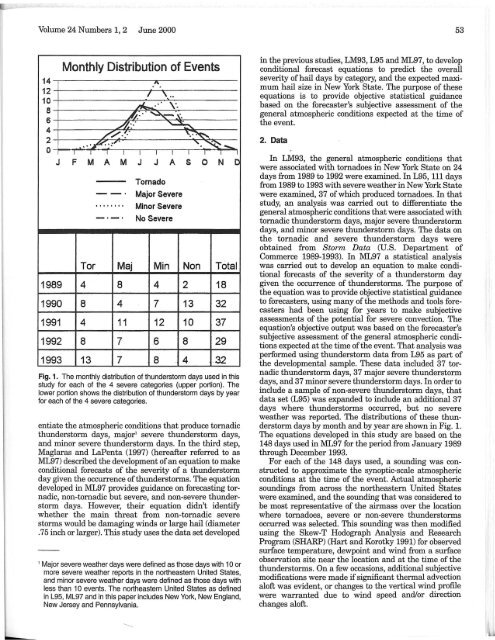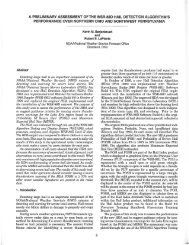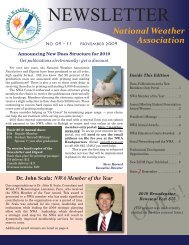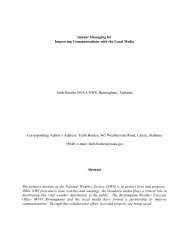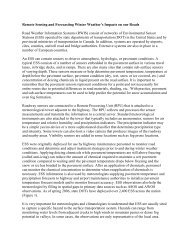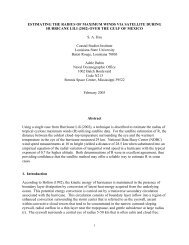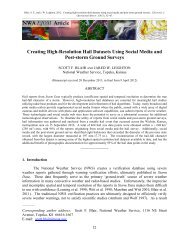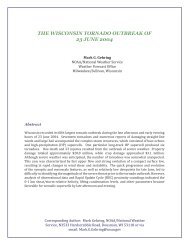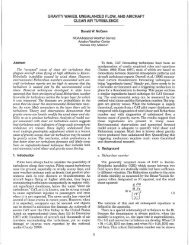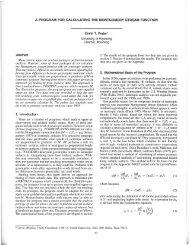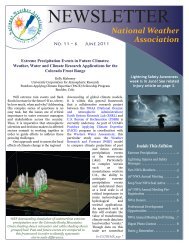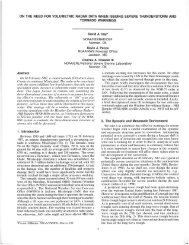development of forecast equations to predict the severity of hail ...
development of forecast equations to predict the severity of hail ...
development of forecast equations to predict the severity of hail ...
Create successful ePaper yourself
Turn your PDF publications into a flip-book with our unique Google optimized e-Paper software.
Volume 24 Numbers 1, 2 June 2000<br />
53<br />
Monthly Distribution <strong>of</strong> Events<br />
14 ,n.,<br />
12 I<br />
". "<br />
10 /4-.. '<br />
S<br />
//.. ",<br />
~-~\",<br />
6<br />
A:: ~<br />
4<br />
//.~: ".~,<br />
2<br />
.. -L~':" ',~~<br />
0 I I I I I I I I I I I<br />
J F M A M J J A S 0 N 0<br />
Tornado<br />
-_. Major Severe<br />
• II" I. I<br />
Minor Severe<br />
_1_' No Severe<br />
Tor Maj Min Non Total<br />
1989 4 8 4 2 18<br />
1990 8 4 7 13 32<br />
1991 4 11 12 10 37<br />
1992 8 7 6 8 29<br />
1993 13 7 8 4 32<br />
Fig. 1. The monthly distribution <strong>of</strong> thunders<strong>to</strong>rm days used in this<br />
study for each <strong>of</strong> <strong>the</strong> 4 severe categories (upper portion). The<br />
lower portion shows <strong>the</strong> distribution <strong>of</strong> thunders<strong>to</strong>rm days by year<br />
for each <strong>of</strong> <strong>the</strong> 4 severe categories.<br />
entiate <strong>the</strong> atmospheric conditions that produce <strong>to</strong>rnadic<br />
thunders<strong>to</strong>rm days, major! severe thunders<strong>to</strong>rm days,<br />
and minor severe thunders<strong>to</strong>rm days. In <strong>the</strong> third step,<br />
Maglaras and LaPenta (1997) (hereafter referred <strong>to</strong> as<br />
ML97) described <strong>the</strong> <strong>development</strong> <strong>of</strong> an equation <strong>to</strong> make<br />
conditional <strong>forecast</strong>s <strong>of</strong> <strong>the</strong> <strong>severity</strong> <strong>of</strong> a thunders<strong>to</strong>rm<br />
day given <strong>the</strong> occurrence <strong>of</strong> thunders<strong>to</strong>rms. The equation<br />
developed in ML97 provides guidance on <strong>forecast</strong>ing <strong>to</strong>rnadic,<br />
non-<strong>to</strong>rnadic but severe, and non-severe thunders<strong>to</strong>rm<br />
days. However, <strong>the</strong>ir equation didn't identify<br />
whe<strong>the</strong>r <strong>the</strong> main threat from non-<strong>to</strong>rnadic severe<br />
s<strong>to</strong>rms would be damaging winds or large <strong>hail</strong> (diameter<br />
.75 inch or larger). This study uses <strong>the</strong> data set developed<br />
1 Major severe wea<strong>the</strong>r days were defined as those days with 10 or<br />
more severe wea<strong>the</strong>r reports in <strong>the</strong> nor<strong>the</strong>astern United States,<br />
and minor severe wea<strong>the</strong>r days were defined as those days with<br />
less than 10 events. The nor<strong>the</strong>astern United States as defined<br />
in L95, ML97 and in this paper includes New York, New England,<br />
New Jersey and Pennsylvania.<br />
in <strong>the</strong> previous studies, LM93, L95 and ML97, <strong>to</strong> develop<br />
conditional <strong>forecast</strong> <strong>equations</strong> <strong>to</strong> <strong>predict</strong> <strong>the</strong> overall<br />
<strong>severity</strong> <strong>of</strong> <strong>hail</strong> days by category, and <strong>the</strong> expected maximum<br />
<strong>hail</strong> size in New York State. The purpose <strong>of</strong> <strong>the</strong>se<br />
<strong>equations</strong> is <strong>to</strong> provide objective statistical guidance<br />
based on <strong>the</strong> <strong>forecast</strong>er's subjective assessment <strong>of</strong> <strong>the</strong><br />
general atmospheric conditions expected at <strong>the</strong> time <strong>of</strong><br />
<strong>the</strong> event.<br />
2, Data<br />
In LM93, <strong>the</strong> general atmospheric conditions that<br />
were associated with <strong>to</strong>rnadoes in New York State on 24<br />
days from 1989 <strong>to</strong> 1992 were examined. In L95, 111 days<br />
from 1989 <strong>to</strong> 1993 with severe wea<strong>the</strong>r in New York State<br />
were examined, 37 <strong>of</strong> which produced <strong>to</strong>rnadoes. In that<br />
study, an analysis was carried out <strong>to</strong> differentiate <strong>the</strong><br />
general atmospheric conditions that were associated with<br />
<strong>to</strong>rnadic thunders<strong>to</strong>rm days, major severe thunders<strong>to</strong>rm<br />
days, and minor severe thunders<strong>to</strong>rm days. The data on<br />
<strong>the</strong> <strong>to</strong>rnadic and severe thunders<strong>to</strong>rm days were<br />
obtained from S<strong>to</strong>rm Data (U.S. Department <strong>of</strong><br />
Commerce 1989-1993). In ML97 a statistical analysis<br />
was carried out <strong>to</strong> develop an equation <strong>to</strong> make conditional<br />
<strong>forecast</strong>s <strong>of</strong> <strong>the</strong> <strong>severity</strong> <strong>of</strong> a thunders<strong>to</strong>rm day<br />
given <strong>the</strong> occurrence <strong>of</strong> thunders<strong>to</strong>rms. The purpose <strong>of</strong><br />
<strong>the</strong> equation was <strong>to</strong> provide objective statistical guidance<br />
<strong>to</strong> <strong>forecast</strong>ers, using many <strong>of</strong> <strong>the</strong> methods and <strong>to</strong>ols <strong>forecast</strong>ers<br />
had been using for years <strong>to</strong> make subjective<br />
assessments <strong>of</strong> <strong>the</strong> potential for severe convection. The<br />
equation's objective output was based on <strong>the</strong> <strong>forecast</strong>er's<br />
subjective assessment <strong>of</strong> <strong>the</strong> general atmospheric conditions<br />
expected at <strong>the</strong> time <strong>of</strong> <strong>the</strong> event. That analysis was<br />
performed using thunders<strong>to</strong>rm data from L95 as part <strong>of</strong><br />
<strong>the</strong> <strong>development</strong>al sample. These data included 37 <strong>to</strong>rnadic<br />
thunders<strong>to</strong>rm days, 37 major severe thunders<strong>to</strong>rm<br />
days, and 37 minor severe thunders<strong>to</strong>rm days. In order <strong>to</strong><br />
include a sample <strong>of</strong> non-severe thunders<strong>to</strong>rm days, that<br />
data set (L95) was expanded <strong>to</strong> include an additional 37<br />
days where thunders<strong>to</strong>rms occurred, but no severe<br />
wea<strong>the</strong>r was reported. The distributions <strong>of</strong> <strong>the</strong>se thunders<strong>to</strong>rm<br />
days by month and by year are shown in Fig. 1.<br />
The <strong>equations</strong> developed in this study are based on <strong>the</strong><br />
148 days used in ML97 for <strong>the</strong> period from January 1989<br />
through December 1993.<br />
For each <strong>of</strong> <strong>the</strong> 148 days used, a sounding was constructed<br />
<strong>to</strong> approximate <strong>the</strong> synoptic-scale atmospheric<br />
conditions at <strong>the</strong> time <strong>of</strong> <strong>the</strong> event. Actual atmospheric<br />
soundings from across <strong>the</strong> nor<strong>the</strong>astern United States<br />
were examined, and <strong>the</strong> sounding that was considered <strong>to</strong><br />
be most representative <strong>of</strong> <strong>the</strong> airmass over <strong>the</strong> location<br />
where <strong>to</strong>rnadoes, severe or non-severe thunders<strong>to</strong>rms<br />
occurred was selected. This sounding was <strong>the</strong>n modified<br />
using <strong>the</strong> Skew-T Hodograph Analysis and Research<br />
Program (SHARP) (Hart and Korotky 1991) for observed<br />
surface temperature, dewpoint and wind from a surface<br />
observation site near <strong>the</strong> location and at <strong>the</strong> time <strong>of</strong> <strong>the</strong><br />
thunders<strong>to</strong>rms. On a few occasions, additional subjective<br />
modifications were made if significant <strong>the</strong>rmal advection<br />
al<strong>of</strong>t was evident, or changes <strong>to</strong> <strong>the</strong> vertical wind pr<strong>of</strong>ile<br />
were warranted due <strong>to</strong> wind speed and/or direction<br />
changes al<strong>of</strong>t.


